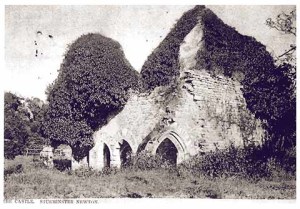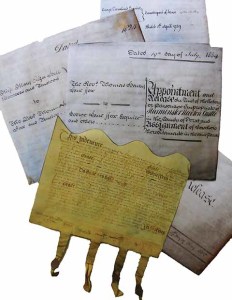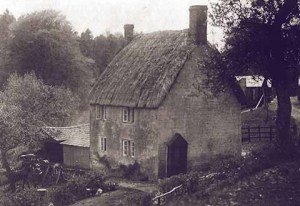Sturminster Castle: the house of Neweton
Imogen Bittner explores the history of Sturminster Castle and seeks the date of its ruin
Published in September ’17
If you wander down from the town’s centre to Sturminster Bridge in winter or early spring, make time to pause and look up towards the tree-line on the top of the hill ahead of you. There you will see the triangular shape of the back wall of ‘Sturminster Castle’, or rather the ruins of the medieval manor house of Newton.
As a child, growing up in the shadow of the castle, I used to scale the bank armed with a spoon and, with one eye on the lookout for the farmer’s wife, search for the golden table that was reputedly buried there. All I uncovered was damp plaster that had fallen from the walls and, once, an arrow-shaped mason’s mark, carved in the stone beneath one of the arches that is no longer there.
I am still fascinated by the site and, by researching old deeds and wills, have begun to answer my childhood questions: to whom did it belong and when did it became a ruin?
The manor of Neweton, or Newton, was given to Glastonbury Abbey by King Edmund Ironside in 1016, adding to the land at Sturminster just over the river granted by King Edgar in 968. It was the larger of the two Dorset estates owned by the abbey; the other (at Buckland Newton) was used largely for sheep production, providing wool and meat for the Abbey. Newton Manor was mainly arable, although its fertile river valley provided enough pasture to feed livestock throughout the winter months, enabling a breeding stock of pigs, horses and oxen to be reared.
Most of the Abbey’s farms lay in Sturminster Newton and court hearings were annually held in the manor which was the administrative, or rectorial, centre of the Newton estate, overseen by a bailiff, who also supervised the tithes that were collected and stored for the Abbey.
In the 14th century, Glastonbury’s Abbot, Walter de Monyton (1342 -1375), in a letter recorded in the Cambridge Manuscript, writes that the manor house at Newton was entirely rebuilt: ‘Save the old room of the bailiff and the principal chamber of the lord – which, however, was adorned by the addition of new windows’.
Hutchins, in his first edition of The History and Antiquities of the County Of Dorset, published in 1774, corroborates that it was rebuilt slightly to the north of an earlier castle or manorial. Hutchins refers to Coker’s Survey of Dorsetshire of 1622, which in turn quotes information that: ‘It is probable that the castle referred to by Leland and Camden [16th- and 17th-century surveys], which existed in Saxon times, stood immediately within the earthwork, and when it fell into decay, about the 12th or 13th century, another castle or large manorial house was built a little further to the north…Some remains of which – wherein are several doors with elliptical arches of Early-English character, and two small rooms, where probably courts were formally kept – still exist.’ Hutchins does not specify that the building was in ruins, although his description of the elliptical arches of Early English character can still be seen today as part of the present ruin, and were also in this state at the end of the 19th century.
A description of the building from the manuscript account of an anonymous author writing in 1579: ‘…where was of old a castle, now decayed, but a bewtifull house on ytt, called Sturminster Newton Castle…’ This information, and the fact that at that time of Hutchins’s first edition there is proof, through deeds and leases, that the building was being lived in, leased and sold for substantial amounts of money to people of social standing in the community, all indicate that it was definitely not a ruin at the turn of the 18th and 19th centuries.
After the Dissolution in 1539, the Dorset estates of Glastonbury Abbey went to Henry VIII, who granted them to Katherine Parr in 1543. On her death, the estates reverted to Henry’s heir, Edward VI, who gave them to his half-sister, Princess, later Queen, Elizabeth. By 1562, the lands that originally comprised Newton Manor had been divided up into separate parcels. Only the manor house and its surrounding lands formed the Newton Estate, which she granted to her cousin, Thomas Howard, Viscount Bindon. In leases and wills dating from this time until its last sale as a standing, habitable house in the 19th century, it was referred to as ‘the impropriate rectory’ or ‘impropriate parsonage’ (ie. an ecclesiastical property that has been placed in the hands of
a layman).
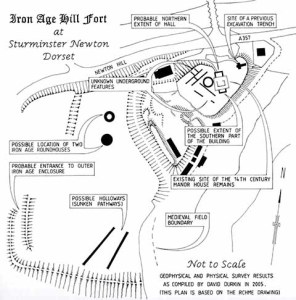
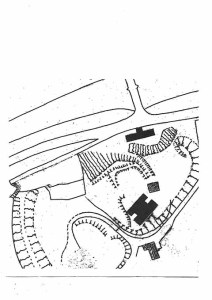
David Durkin’s Survey Map of Sturminster Catle and other items of archaeological interest, with a more detailed image of the h-shaped ‘castle’ building itself shown below it
Thomas Howard sold both his Newton estate and his manor in Poxwell in 1575 to John Henning, a wealthy merchant from Poole. In the deed of sale also marked on site are the parsonage barn (undoubtedly the tithe barn dating from the time it belonged to Glastonbury Abbey) and a culver house (dovecote), The Shambles or Market House, lands in Coombs and three acres of land in Steart Mead. It remained in the Henning family until Thomas Trenchard married John Henning’s granddaughter, Elizabeth Henning, in 1695.
During that 120 years there was the Civil War, when Royalists set up a garrison here as it was in a strategic position overlooking the river crossing, which they abandoned before it was taken over by the Parliamentarians under Sir Anthony Ashley Cooper. Famously, on 3 July 1645, 4000-5000 Dorset Clubmen ‘forced the parliamentarians’ quarters at Sturminster Newton, divers slain and wounded on both sides and they took sixty dragoons’ horses and arms from the Parliament’s forces, for restitution whereof Colonel Massey sent a trumpeter to them, and they promised to make restitution the next day.’ (Written by an eye witness named Whitelock).
In the Commonwealth Survey of Sturminster Newton Castle written on 26 June 1650, the Inquisitors did ‘severally and particularly find that there is an impropriate parsonage in the parish of Sturminster Newton Castle…’.
It is in 1726 that mention is made of a Castle Farm House. The entire site was leased by George Trenchard (son of Thomas and Elizabeth) to William Baker, ‘gentleman’, from Sturminster Newton Castle. The lease was for seven years, for a sum of £54 annually (about £10,000 in modern money) and included ‘the impropriate rectory or parsonage, the parsonage barn, Culverhouse, lands in Coombs and Steart Mead and a dwelling house in Coombs, lately rebuilt’.
Castle Farm House displays features of pre-16th-century architecture in its ashlar stone mullioned windows, which, more likely than from the impropriate parsonage, came from another building described in Hutchins: ‘Near this is an old building, supposed to have been the rectorial house, the glebe [its ecclesiastical lands] of the rectory being called Coombs, being adjacent to it. Adjoining to it were the remains of the rectorial barn, great parts of which were pulled down in 1732. [Later editions add ‘The remainder in 1840’.] Probably a monk or two of Glastonbury were placed here as bailiffs or stewards, to take care of the lands and revenues’.
The oldest known tithe map of Sturminster, dated to 1783, shows an H-shaped building standing alone on the site and whilst this is not definitive proof of its shape or style, it shows a far more substantial building than the present ruinous one.
In 1803, the impropriate rectory was sold to William Woodrow of Ringwood, although Trenchard kept the orchard, garden and dwelling of what is now known as Castle Farm and Girdlers Mead. His daughter, Mary Woodrow, sold it in 1824 for £2200 to Thomas Henry Lane Fox, curate of St Mary’s church. At this time the parsonage or rectorial barn was recorded in the sale but only the ‘site of the culverhouse’. That same year, Lane Fox bought other properties (Castle Farm House, garden and orchard and Girdlers Mead) from William Trenchard for £240 and £140 respectively. The Market House was later sold by Trenchard to a John Bird. In 1834, Lane Fox sold the entire estate to his cousin, George Pitt-Rivers, for the price he had paid for it ten years earlier.
The rectorial barn was completely demolished by 1840 and although the manor house or impropriate rectory had been occupied until 1834, it started to decline and was a complete ruin by the latter half of the 19th century. It was used as an atmospheric backdrop for Hardy’s plays and the small dwelling, now known as Castle Farm (grade II listed), became the main habitable property on the site.
In 2017, the privately owned and inaccessible ruins of the manor house, on its promontory hill fort, is a grade II* scheduled ancient monument and is of local and national importance; it is also currently on Historic England’s At Risk register.
The author, as curator of Sturminster Newton Museum and Mill Society, will mount a more in-depth exhibition of her research, which will be open to the public, in early 2018. www. sturminsternewton-museum.co.uk
